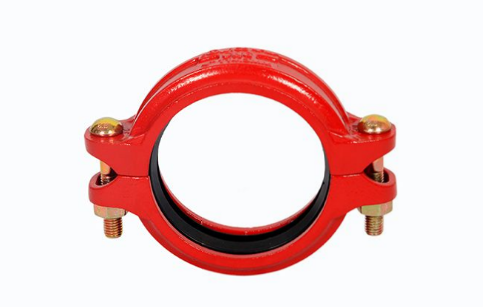What Is a Grooved Pipe Joint?
In the world of piping systems, the grooved pipe joint is a popular choice for joining pipes, especially in applications where efficiency and ease of installation are key priorities. The grooved pipe joint offers numerous advantages, such as reduced installation time, flexibility in pipe alignment, and resistance to leakage. But what exactly is a grooved pipe joint, and how does it work?
Understanding Grooved Pipe Joints
The pipe groove is made by forming or machining an actual groove into the ends of two pipes. A gasket wraps around and on top of the pipe ends, the housings wrap around the gasket and sit in the pipe grooves, and the bolts and nuts are tightened with a wrench to hold it all together. The coupling fits into the groove of the pipe ends, creating a secure, tight seal without the need for welding, threading, or flanging. This makes the grooved joint a versatile and efficient option for pipe connections in different systems.
The pipe ends are typically grooved with a special machine that forms a uniform groove, allowing the coupling to slide into place. The coupling usually has a rubber gasket or O-ring inside, which helps to create a leak-proof seal.
Key Components of a Grooved Pipe Joint
The main components of a grooved pipe joint are:
- Grooved Pipe Ends: The pipe ends are mechanically grooved to allow for easy connection with the coupling.
- Grooved Coupling: This is a specially designed fitting that connects the grooved pipe ends. The coupling typically has two halves that fit around the pipe ends.
- Rubber Gasket or O-Ring: A gasket is placed inside the coupling to ensure a tight, leak-proof seal when the pipe ends are connected.
How Do Grooved Pipe Joints Work?
Grooved pipe joints are installed in a relatively simple process that requires fewer tools and less labor compared to traditional methods like welding. Here's how the installation works:
1. Preparing the Pipe Ends: The ends of the pipes are mechanically grooved using a grooving tool. The groove is typically made about 1 to 1.5 inches deep.
2. Fitting the Coupling: A grooved coupling is placed around the grooved ends of the pipes. The coupling is designed to fit snugly and cover the grooved area.
3. Installing the Gasket: A rubber gasket is inserted into the coupling to ensure a tight seal. The gasket helps to prevent leaks, even when the pipes are exposed to high pressure or temperature changes.
4. Tightening the Coupling: The coupling is then tightened using bolts. This secures the pipes in place, creating a strong and reliable joint.
One of the main advantages of grooved joints is the speed of installation. Unlike welded joints, which require heat and potentially hazardous equipment, grooved joints can be installed quickly with minimal tools.
Advantages of Grooved Pipe Joints
There are several advantages to using grooved pipe joints in a variety of applications:
1. Quick and Easy Installation
Grooved pipe joints are faster to install than traditional methods like welding or threading. Since they don't require any welding or heat, installation is safer, quicker, and more cost-effective. This is particularly useful in environments where downtime must be minimized.
2. Flexibility and Adjustability
Grooved pipe joints offer flexibility in terms of alignment and adjustment. The system allows pipes to be easily aligned and re-adjusted if necessary. This is beneficial in systems that require frequent changes or maintenance.
3. Leak-Proof Seal
The rubber gasket in the grooved coupling ensures that the connection is tight and leak-proof. This is essential in maintaining the integrity of piping systems, especially in industries where leaks can be costly or hazardous.
4. Resistance to Vibration and Expansion
Grooved joints are capable of absorbing vibration and thermal expansion. This makes them ideal for applications where pipes are subjected to movement, such as in HVAC systems, fire protection systems, and industrial plants.
5. Easy to Maintain
If a pipe needs to be repaired or replaced, grooved joints can be disassembled and reassembled without damaging the components. This makes maintenance and modifications easier compared to other types of joints, such as welded or flanged joints.
Applications of Grooved Pipe Joints
Grooved pipe joints are used in a wide range of industries and applications, including:
- Fire Protection Systems: The ability to quickly install and maintain piping systems makes grooved joints ideal for fire sprinkler systems.
- HVAC Systems: Grooved pipe joints are commonly used in heating, ventilation, and air conditioning systems where flexibility and easy installation are needed.
- Industrial Applications: Grooved pipe joints are also used in industrial settings, including manufacturing plants, water treatment facilities, and chemical processing.
- Plumbing Systems: They are often used in plumbing systems to reduce installation time and improve system reliability.
Conclusion
Grooved pipe joints have revolutionized the way pipes are connected in modern systems. They provide significant benefits, including quick installation, leak-proof seals, and the ability to handle vibrations and thermal expansion. With their wide range of applications, grooved pipe joints are indispensable in industries like fire protection, HVAC, and plumbing.
If you're looking for high-quality grooved pipe joints, be sure to choose a trusted supplier who offers reliable and durable products. If you have any questions or need more information, feel free to contact us. We are happy to assist you with your piping needs.





